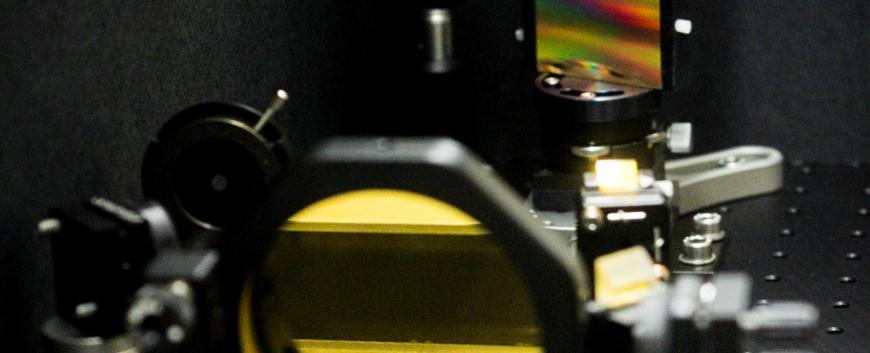
The special position of terahertz (THz) waves in the electromagnetic spectrum determines its unique physical properties and promising applications, such as particle acceleration. During the past decade, THz science has experienced rapid progress and started to move from the research stage to practical applications. One of the key factors hindering the THz development lies in the severe lack of strong THz sources.
The present invention relates to a device and method for generating terahertz pulses of 1 to 100 cycles with an energy of a few mJ. At present, optical rectification of ultrashort laser pulses in lithium niobate (LiNbO3 – LN) crystals can produce THz pulses with the highest energy (0.4 mJ) and frequency suitable for particle acceleration (0.2 - 1.0 THz). The THz wave are produced with tilted-pulse-front (TPF) excitation developed by the Institute of Physics at the University of Pécs.
The efficiency of the tilted-pulse-front LN THz source reaches 2%. However, there are two problems. On the one hand, a further significant increase in THz energy is not possible due to imaging errors in the TPF array. On the other hand, the beam of THz pulses generated by the TPF LN system is of poor quality because a prism-shaped LN crystal must be used to form an asymmetric THz beam. Poor beam quality drastically limits application to particle acceleration.
As a solution, we proposed the use of a hybrid TPF arrangement. This is a traditional TPF layout utilizing contact grid LN crystal combination. According to model calculations, the imaging error in this hybrid TPF arrangement is much smaller than in the conventional TPF arrangement, and the angle of the LN prism is preferably smaller than in the conventional TPF arrangement.
Unfortunately, it is currently not possible to make a high scratch density LN contact grating with the required parameters. We proposed a solution that is a hybrid TPF arrangement. This does not include the first order LN contact grid, but a high (approximately 200) order LN step contact grid. In this case, instead of the LN prism, it is planar in parallel shape, which ensures ideal THz beam quality.
The present invention comprises a planar parallel LN crystal having a rectangular triangular prism structure (roof series) that periodically repeats along the back surface. The surface elements are created with the original flat surface and they enclose half the angle of the pulse front inclination required for speed matching (62 degrees for LN). Pumping pulses fall perpendicular to the front (plane) surface of the LN crystal and pass through the LN crystal. They are reflected on its rear roof-shape surface, and travel 62 degrees to the right and left with the incident beam. Although the reflected pulse front segments do not tilt in the reflected beams, the envelope of the segments does, and it runs parallel to the two surfaces of the LN. Thus, the resulting THz pulses travel perpendicular to the front surface of the LN. They exist on the first interface and can be sent in the right direction for the applications using a dichroic beam splitter.
The solution or device does not include any other elements, imaging lenses, or optical gratings. The LN crystal is in parallel. As a result, this device can be scaled as desired (and thus the energy of the THz pulses can be increased as desired) and it provides an ideal THz beam.
CONTACT
Pécsi Tudományegyetem | Kancellária | Informatikai és Innovációs Igazgatóság 2021.

